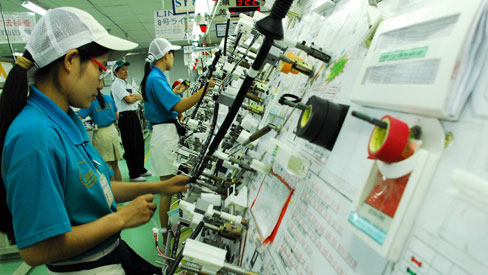FIEs remain tight-lipped in technology transfers
Attracting high technology from foreign firms is still far from a reality in Vietnam, much to the bane of local enterprises.
The Central Institute of Economic Management has released a report on firm-level technology and competitiveness in Vietnam. The report was compiled using data from five high-profile surveys concerning over 38,731 local and foreign enterprises during 2010-2014.
Results showed that technological advancements usually came from domestic firms. Over 80% of technology transfers took place between domestic firms in the past five years across both related and unrelated sectors. This illustrates that foreign firms have been responsible for just 20% of technology transfers to domestic firms in the observed period. The rate of technology transferred from foreign firms increased from 1% in 2009 to 10% in 2013.
“Overall, technology transfers primarily take place among domestic firms in Vietnam, suggesting that foreign direct investment (FDI) may not be as effective a way towards technological advancement as previously believed”, said Professor John Rand from the University of Copenhagen, which supported the making of the surveys and the report.
 |
“Local crowding is a threat because domestic firms base their strategy on copying and adapting practices from foreign invested enterprises (FIEs) who do not easily concede the know-how”, he said.
Christian Brix Moller, deputy head of mission from the Danish Embassy to Vietnam, speaking of Vietnam’s FDI attraction strategy, said the country wanted to receive high technology from FIEs which often received many investment incentives. However, the technology transferred to domestic firms came from other domestic firms using low and medium technology.
This was a big problem that Vietnam’s government should have paid attention to when it wanted to redesign its FDI attraction policy, he said.
Rand also suggested that “The lack of learning between foreign and domestic firms suggests that additional policy efforts in attracting and managing FDI may be required for capturing productivity spillovers.
“The Vietnamese government has given big incentives for FIEs in the hope that they will transfer high technology to local enterprises. However, only 20% of FIEs have done that. Thus the government needs to reconsider its FDI attraction policy”, local economist Pham Chi Lan said.
Do Ngoc Vinh, general secretary of the Vietnam Coffee and Cocoa Association, said Vietnam had 15 coffee FIEs, but none of them had transferred any processing or cultivation technology to Vietnamese partners.
Another problem, according to this report, is that only a small number of local firms have invested in research and development (R&D). The number of firm investing in R&D declined from 769 in 2009 to 477 in 2013. In 2009, firms were mostly focused on research that was aimed at creating new markets, while in 2013, the majority of research expenditure (53%) was used for developing technology within existing markets.
Frontier research, which is dedicated to generating a product new to the world, represents only 3% of research expenditure.
